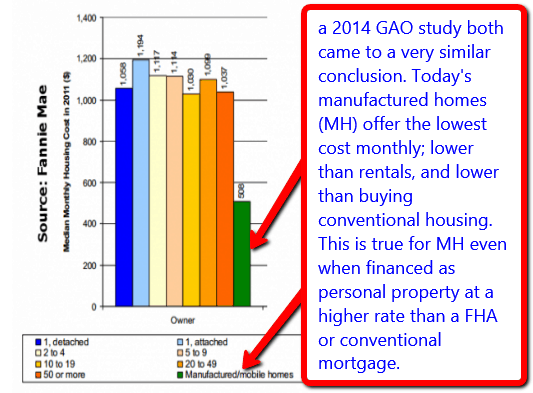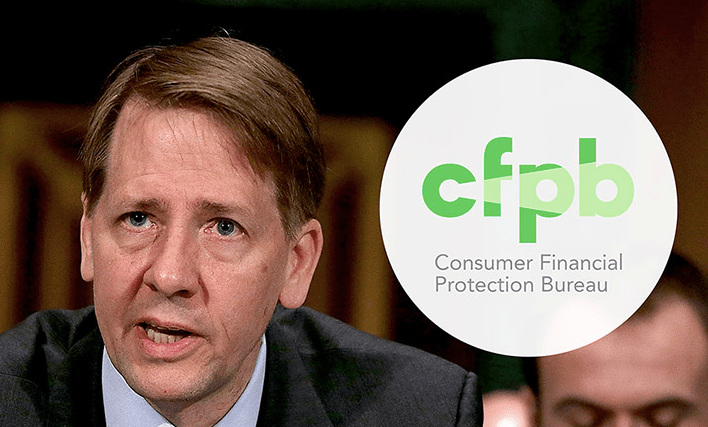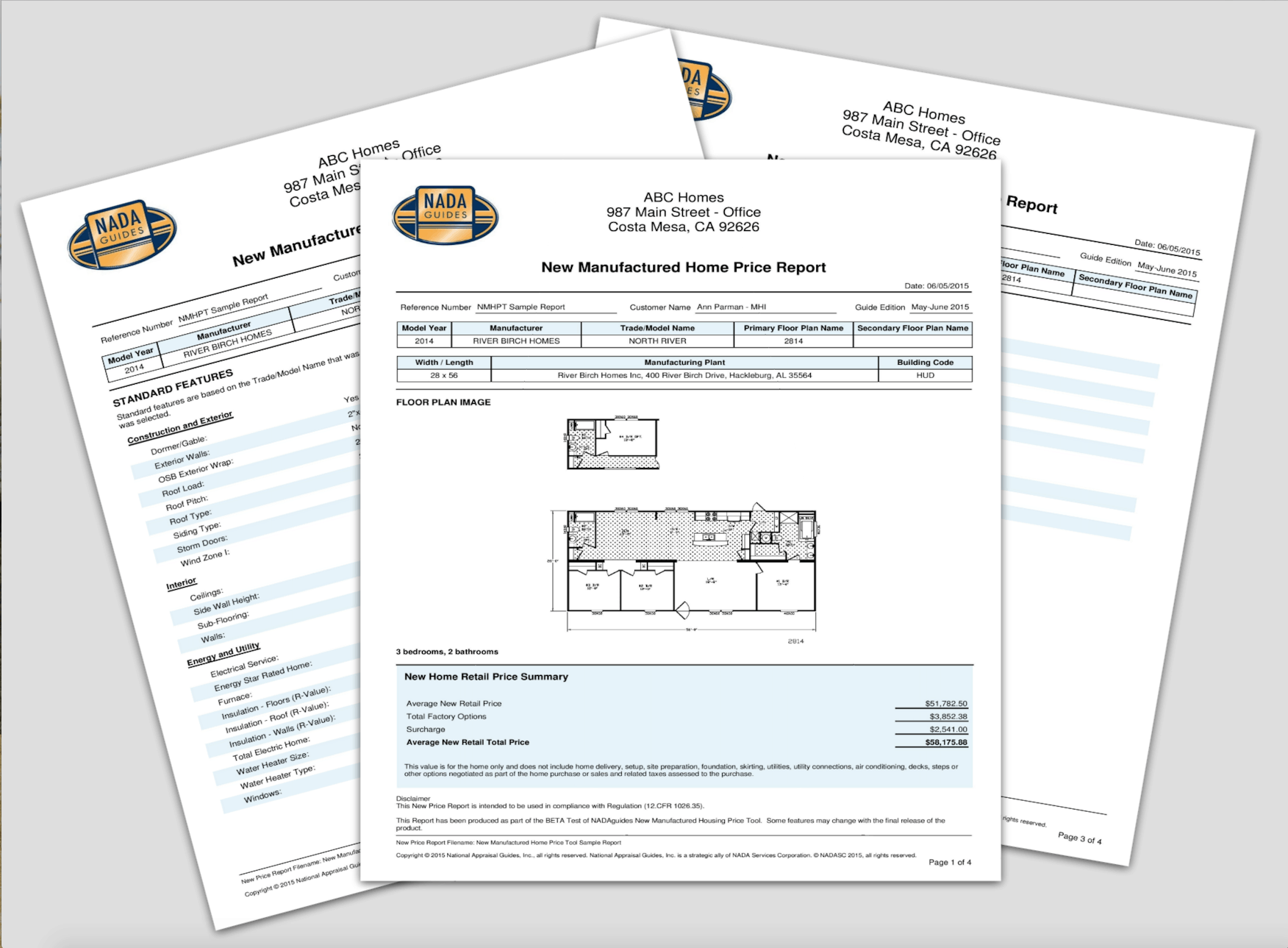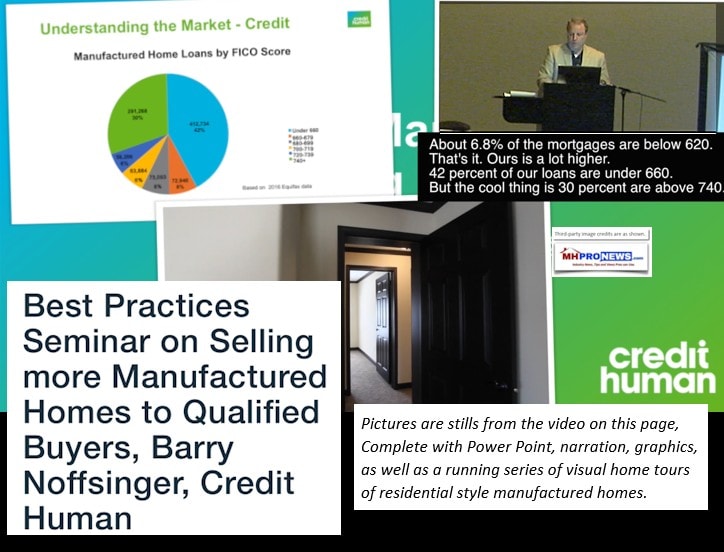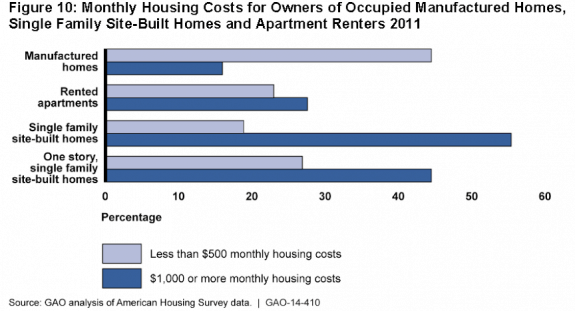with – Kevin Clayton, Joe Stegmayer, Keith Anderson, Gary McDaniel, Todd Baker and Don Westphal
“We have to learn how to reach out and communicate with them (Millenials).”
— Keith Anderson – Champion Home Builders
Model home, Champion Home Builders.
Moderated by energetic 45-year industry veteran Dick Ernst, the “Where Do We Go From Here?” session was the first packed MHI Congress and Expo forum in years.
Some 700 professionals were in the room to hear CEOs:
Kevin Clayton – Clayton Homes
Joe Stegmayer – Cavco Industries (CVCO)
Keith Anderson – Champion Home Builders
Gary McDaniel – Yes! Communities
Todd Baker – Equity Lifestyle Properties (ELS)
Don Westphal, MH development consultant
In the past seven years, the manufactured housing industry’s new home shipments have averaged some 8 percent annual growth. Ernst said there is so much potential from the industry’s production centers and on-site finish work, that manufactured housing could dominate the affordable housing business.
Sante Fe style home, solar roof panels, Cavco Industries, photo credit MHLivingNews.com
In his tee-up for the opening question to Joe Stegmayer, Ernst noted:
The U.S. needs 1.3 million to 1.4 million new housing starts a year to keep up with a rising population.
MH builders sold some 70,000 new HUD Code homes in 2015, with another 700,000 single family houses constructed by site builders.

The pithy and witty Stegmayer began with a one word reply.
“Yes.”
Once smiles and laughs subsided, Joe explained why there is an opportunity for manufactured housing to grow its market share.
First-time home buyers generate 55 percent of new mortgages.
Conventional on-site stick builders are reluctant to build entry level housing units.
With new starts growing, there is also growth in the affordability gap.
“We don’t think we will take over” site-building, Stegmayer said, but we can join that market.
“We’ve been as high as 15-to-20 percent of all single family homes sold,” and Cavco’s CEO sees
a significant upside for MH in the total single-family housing market.
Clayton Homes iHouse – photo credit, Inhabitat.
Ernst – Other Factors That Bode Well for MH
Dick Ernst then noted that with:
Seniors downsizing,
Single parent households rising, and
Millennials becoming the largest consumer group, the demographics are ripe for MH.
He asked Kevin Clayton to take attendees behind the scenes of some of Clayton Homes’ efforts to attract these potential buyers.
Clayton’s CEO said the new generation loved the iHouse, but asked – where do I put it?
A common comment was that buyers want better places to place manufactured homes.
When people traditionally hit their 40s, they were buying houses like crazy. But Clayton believes Millennials won’t automatically have that same impulse.
Focus groups that Clayton Homes has done revealed interest in:
Improved exteriors
50 percent have concern over quality and safety
The question then becomes: How does one go about changing those perceptions?
Kevin Clayton emphasized the need to change perceptions, and noted that other industries have done it, citing online dating as but one example of how that was successfully done.
Champion’s CEO’s Take
Champion Home Builders’ Keith Anderson jumped in next. Anderson said it was important to get plugged into and reaching out to Millennials.
He stressed they could do it through their own employee base that fits that demographic group, as well as on the consumer side.
“We have to learn how to reach out and communicate with them,” Anderson said.
For 18 months, Champion has been using new websites, efforts on social media, MHVillage and other outreaches. They are seeing website hits and leads that rose 500 percent in the last six months alone.

talked about the desire for more amenities from community residents, how they are working with demographic groups and seeking to accommodate their respective needs and desires.
Social media is just one of the many outreaches that McDaniel identified. Engaging in their communities, McDaniel said, they learned that residents wanted more “than a clubhouse with a library.”
As a result of their engagement, they are exploring water parks, walking trails, learning centers, partnerships with local colleges, tutoring and helping residents with resumes, among other services.
With the Hispanic community, they are working to help children and adults assimilate and adapt, to become more successful in the U.S.
“If they are happy and successful,” in their MHCs, then they will clearly make good long-term residents, McDaniel observed.
Don Westphal – Land Development
Don Westphal noted that in working with both conventional and manufactured home projects, the customers inside those homes are “the same inside.”
Those customers want an attractive housing product, landscaped homes, and make their neighborhood look like a place they’d want to live.
He also noted that people are into instant gratification mode, which ought to be an advantage to manufactured housing, with its faster time from start to completion.
“They don’t want to wait for months,” Westphal said.
ELS Promotion on MHVillage.
ELS’ Todd Baker
Baker was working in the conventional housing development business before his current work for ELS in manufactured home communities (MHCs).
As head of consumer research, he said that before to entering manufactured housing, they did 10- to 15-page surveys with every single home buyer.
Stressing that a normal response rate to an in-depth survey might be 1 percent, he noted that they enjoyed a 10 percent response rate.
“Buyers wanted to tell us about their biggest purchase,” Baker said.
He noted that they buy from each of the builders he was on stage with.
They do a mix of single sectional and multi-sectional homes.
They tend to go with open floorplans, with large kitchens.
“Whatever your price point,” Baker said, people routinely want big kitchens.
In surveying buyers, they wanted to know what trade-offs customers where ready to make.
For example, would buyers prefer a larger master bedroom, or a smaller bedroom with a bigger walk-in closet?
Champion Home Builders interior, lower left,
Cavco Chairman and CEO, Joe Stegmayer standing in a Cavco
model home’s kitchen, on the right. Collage photos from MHLivingNews.com
$150K-$175K “All-In” Costs for the Package
With site builders targeting $300,000 for many conventional houses, manufactured housing needs to focus on homes that are $150,000 to $175,000 total for the “all in” cost.
Energy savings and architectural appeal have to be part of that effort.
Kevin Clayton said that he was happy to see Fannie Mae and Freddie Mac officials at the Congress and Expo forum this year.
Clayton’s CEO said they have to “chip away” at the financing difference, because there is “erosion” in the value proposition due to the differences in lending.
But what Clayton will prioritize this year are exteriors, he said. Clayton spoke about shipping dormers or other items on a separate carrier, and he said that it will be a game changer for the industry.
He felt that interiors of manufactured homes were a full 10 years ahead of exteriors, which clearly have to catch up to grow market share.
“Don’t leave those who brought you to the dance…”
Clayton stressed that there is no desire to leave the entry level side of the business, nor should there be any wish to leave those “who brought us to the dance.”
He explained that the U.S. Department of Transportation and HUD need to embrace “how wonderful our processes are,” and they needed to be part of the solution that manufactured housing can uniquely bring to the housing market.
Destroying the Trailer Image
Westphal said, “Now that the interior is nailed, we need to destroy that trailer image,” created by outdated exteriors.
The look of the homes in communities must be pleasing to the eye, the veteran MH development designer stressed.
Value Engineering
Champion’s Anderson said that “value engineering” allowed for steeper roof lines, more porches and other items that could bring additional curb appeal without a lot more cost.
Ernst turned to Cavco’s CEO, and pointed out their use of Santa Fe-style homes as but one example of manufactured housing that could have fresh looks.
Stegmayer said that HUD’s new onsite completion rule was “too onerous,” “too expensive,” and “too laborious” to be useful.
He said that housing is very much a regional business, and explained that they have architects and designers on staff for interiors and exteriors, including those with a Southwestern or Santa Fe regional flare.
Stegmayer went on to explain that multifamily and multi-story projects being done by their firm were being completed on site. He said there was a need to challenge the perceptions of developers who still think they can do it cheaper on site, than by using the efficiency found in factory building.
“Even though we can save time and money, there is a thing called ego,” he said. An example of a SoCal project with higher roof pitches and bolder exterior elevations was discussed.
No Question of Capabilities
Gary McDaniel said there is no question about the capabilities. He also felt the industry must not abandon those who need affordable housing that brought us to the dance.
He concurred with Kevin Clayton, that parity in the capital markets would open more doors for manufactured housing’s competitiveness.
McDaniel also noted that the rental option was important to the industry too, because not everyone wants to buy — at least not right away.
More Interest from Developers
Don Westphal noted that 8 years ago, when housing crashed, there was no interest in learning how to develop with manufactured housing. Last year, 30 attended a seminar on that topic.
This year, that number had doubled.
By identifying what the roadblocks are, and navigating those, new levels of sales could be achieved by the industry.
Exteriors aren’t Everything
McDaniel said that many of their buyers were not that concerned with the exteriors. Having a clean, affordable place to live that was comfortable — that was the key to their success. With their focus on families, as opposed to the senior market, Yes! Communities was creating a place where residents were happy to raise their families.
Be it renting or buying, “Once they experience our home, the misconceptions go away,” McDaniel said.
Renting homes did create new wrinkles, such as how to service that “fleet of homes” in the corporate rental pool.
But he said their customers have “really not changed that much from the 80s, 90s, to 2000s, to now,” adding that the demand for affordable housing was incredible. They were expanding and building to meet that demand.
Clayton’s Move into the Site Building Market
Kevin Clayton explained that they bought builder/developers near Nashville and Atlanta more to learn how to do successful developments, rather than to integrate manufactured housing into
those businesses.
Noting that housing from $150,000 to $225,000 “sells fast,” he felt that if the old MH terminology was bypassed, our industry’s product was poised for growth.
Clayton floated the idea of working with HUD to develop a new class of manufactured housing that would be built to the HUD Code, but would have 5/12 roof pitches, integrated porches and
not use vinyl skirting, with tweaks in foundation and set-up – all of which would then be given a new name for that style of home.
That new class of homes could then have an ad campaign to promote it for zoning and financing acceptance. He said it would be important to show it off as superior, and a way to separate
it from the old mobile home terminology and image.
The session was brought to a conclusion by stating the value proposition for association membership, but also by stressing why the GSEs needed to be on board with chattel lending for manufactured housing.
When 21st, Vanderbilt and other industry lenders could make manufactured home lending work, that clearly implied that the GSEs could do so, too. ##
Connect on LinkedIn.
Free Twice Weekly emailed news, tips updates (Newsletters look like this) sign up free in seconds at MHProNews.com/Subscribe
Office 863-213-4090. Publisher of MHLivingNews.com, MHProNews.com and expert services via MHC-MD.com and LATonyKovach.com.





















